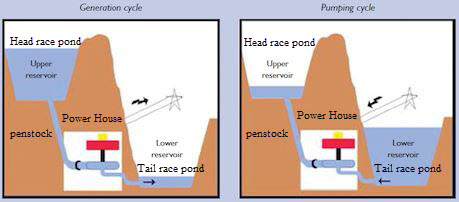Pumped Storage Plant
These are a special type of power plant which works as ordinary hydropower plants for part of the time and when such plants are not producing power, they can be used as pumping stations which pump water from tail race to the head race. During this time, these plants utilize power available from the grid to run the pumping set.
Thus, pumped storage plants can operate only if these plants are interconnected in a large grid.
Principle of Operation
The pumped storage plant is consists of two ponds, one at a high level and other at a low level with powerhouse near the low-level pond. The two ponds are connected through a penstock. The pumped storage plant is shown in fig. 1.

When the plants are not producing power, they can be used as pumping stations which pump water from tail race pond to the head race pond (or high-level reservoir). In this pumping cycle case, generator/turbine assembly works as pump/motor.
When there’s a sudden demand for power, the “head gates” are opened, and water rushes down the tunnels to drive the turbines, which drive the powerful generators. This is called generation cycle. The water then collects in the lower reservoir, ready to be pumped back up later. Water is pumped up to the top reservoir at night when demand for power across the country is low.
It is an igneous way of conserving the limited water resources on the one hand and balancing the load on the distribution system, on the other hand. The plant operates as a source of electrical energy during system peak hours and as a sink during off-peak hours.
Discuss the Role of the Plant in a Large Interconnected Power System?
(a) Increased Reliability of Supply: In the event of power failure at one station, the system can be fed from the other station. Generation in a hydrostation is greatly affected by river flow, storage available, floods and droughts. Forced outages at steam, station depend on efficient working of boilers, turbines and all the associated auxiliary plants. Forced outages, as well as scheduled outages, can be easily met in an interconnected system.
(b) Reduction in Total Installed Capacity: The amount of such reduction depends on the characteristics of the interconnected system and the desired degree of service reliability. In case of isolated operation of power stations, the reserve would have to be maintained separately at each power station. Similarly spinning reserve required in a power system is reduced.
(c) Economic Operations: Various methods of loading the generator units in the most economical way with interconnection should be studied. Savings derived from a reduction in a spinning reserve and economic loading of the generator units can be calculated. This ultimately reduces the total capital and running costs to a minimum.
image reference: hydroworld.com
